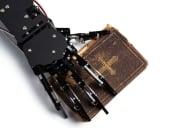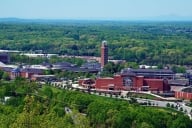You have /5 articles left.
Sign up for a free account or log in.
WASHINGTON — It’s a transition that many Roman Catholic colleges and universities are facing: the generations of priests and nuns who led the college in the past are stepping down, and lay leaders are replacing them.
To maintain the colleges’ strongly Catholic identities, boards of trustees will have to take a stronger hand, a Catholic bishop and a senior fellow of the Association of Governing Boards of Universities and Colleges said to an audience of college presidents assembled here Sunday for the Association of Catholic Colleges and Universities’ annual meeting.
“It’s time for the laity to step up to ensure that the Catholic faith continues into the third millennium,” said the Rev. Joseph P. McFadden, the bishop of Harrisburg, Pa., and the chair of the United States Conference of Catholic Bishops’ Committee on Catholic Education. A Catholic college -- he used the definition propagated by Pope John Paul II, a college that combines Catholic values with rigorous academic work, or “a place of research, a place of probing the mystery of life” -- needs trustees who value its unique mission, he said.
McFadden laid out a few criteria for trustees at Catholic colleges: they should, when possible, be Catholic themselves, he said, and they should be well-educated about the workings of Catholic higher education. The latter was a responsibility for the many college presidents in the audience, who vastly outnumbered the few trustees present. Still, many presidents seemed to agree with the need for trustees committed to the Catholic faith -- as well as the need to educate those trustees about how universities function.
“If we’re not educated and oriented to carrying out the mission and the identity, really affirming both of those, we will not be the kind of trustees that Catholic higher education needs,” said Thomas Longin, senior fellow at the Association of Governing Boards of Universities and College, a former college provost and a trustee at Carroll College, a Catholic liberal arts college in Montana.
Many trustees are “left in the background” because the college assumes they’re uninterested in issues of faith and mission and are interested only in finance and fund-raising, Longin said. But one of the most valuable roles they can play is that of liaisons to the broader Catholic community -- if they understand the mission and goals of the college.
“We’ve got to get beyond [those issues] to a place where we’re taking practical measures to move trustees to serve in a real capacity,” Longin said.
The question of trustees was only one of several identity issues the presidents grappled with at Sunday’s conference. Another was how to embrace their Catholic nature while continuing a tradition of outreach to other faiths, as well as to atheists.
In another conference session, Eboo Patel, founder of the Interfaith Youth Core and a member of the White House Advisory Council on Faith-Based Neighborhood Partnerships, urged Catholic colleges and universities to commit to measuring interfaith harmony and dialog as they would for other types of diversity.
Encouraging students to cooperate with people of other faiths should be a measurable goal and part of a university’s strategic plan, he said. And he encouraged institutions to include even students who are humanist, atheist or agnostic, a concept that some in the audience seemed to find more challenging than engaging with religious people of a different faith. “Otherwise we are affirming a major new cleavage, which is between believers and nonbelievers,” Patel said.
Still, he said, one question that often confronts religious institutions trying to engage in interfaith work -- “How do I maintain my religious identity in a world full of religious diversity?” -- should be easier for institutions that frequently educate a majority non-Catholic student body.
“I think you guys get it instinctively,” he said.








